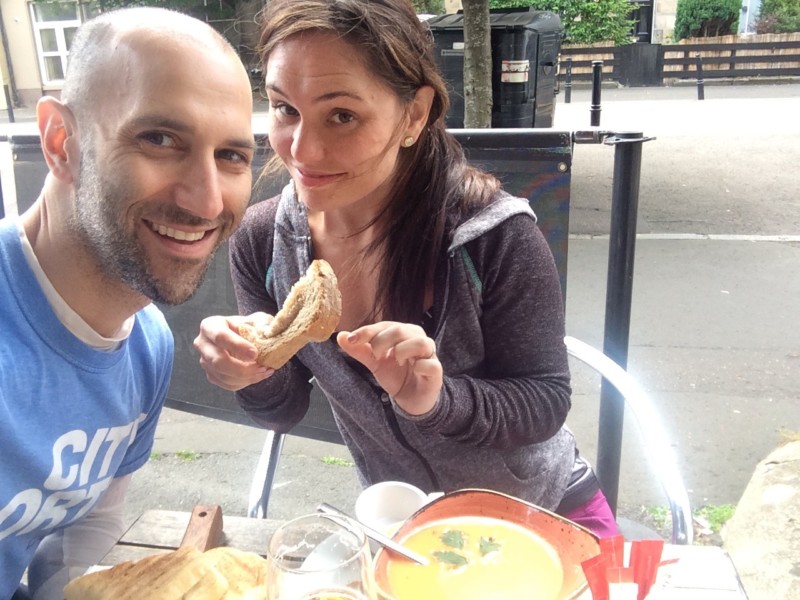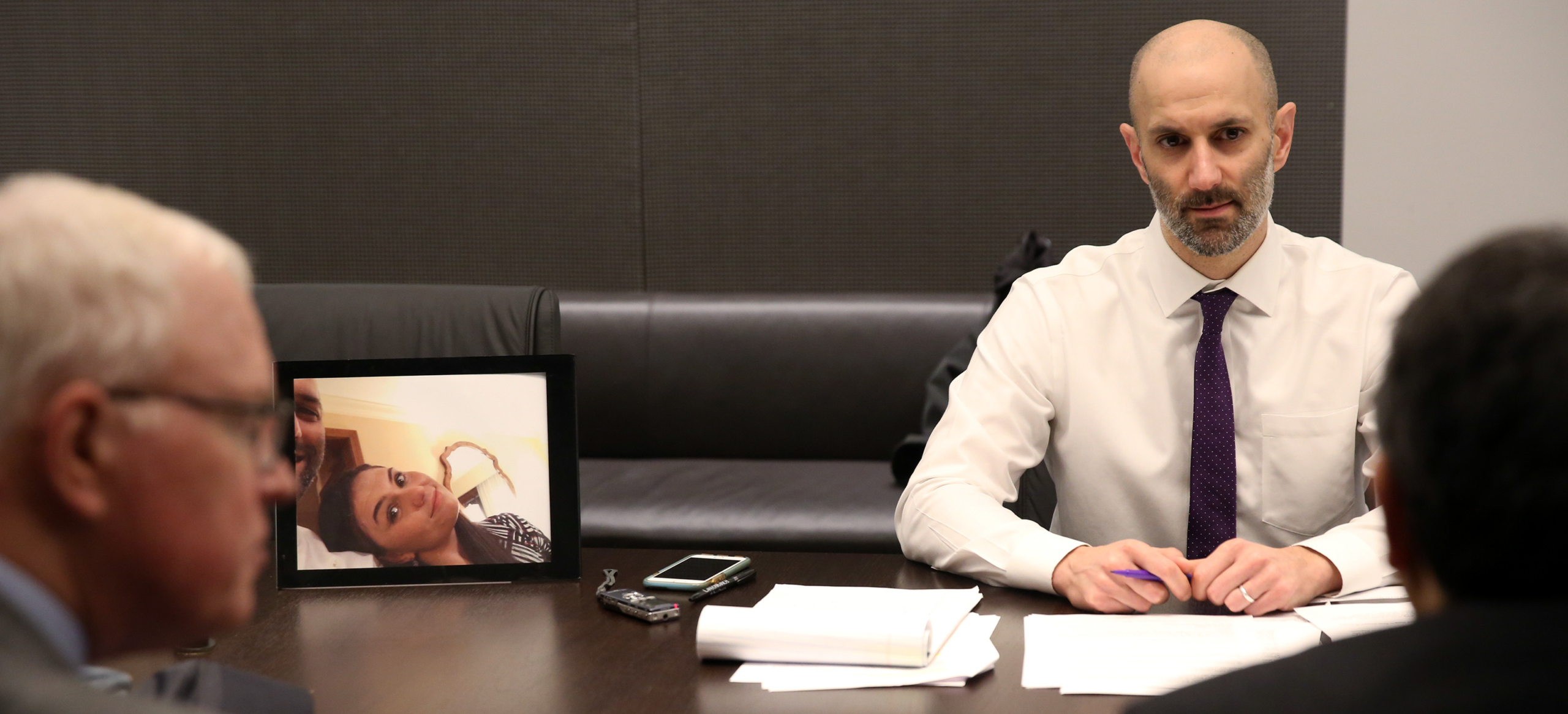The tragic story of 34-year-old Laura Levis’s death went viral in 2016. Peter DeMarco, Levis’s husband, wrote a poignant letter offering his gratitude to the medical staff who cared for his wife in her final days. The letter, which ran in The New York Times and gained attention across the country, detailed gestures from more than a dozen hospital employees that brought DeMarco some solace.
But later, DeMarco learned that what he had been told about his wife’s fatal asthma attack near Somerville Hospital on September 16, 2016, was not the whole story. Levis, he learned, had made it to the doors of the hospital that morning, but found them locked. She then called 911, explaining where she was and her developing health crisis. Despite that, emergency responders failed to reach her in time to resuscitate her. She died on September 22.
DeMarco initially explored legal options in order to expose the series of failures in the emergency response system that led to his wife’s collapse just feet from a hospital door. When he found that Massachusetts law limited how far a lawsuit could go, DeMarco—a longtime Boston Globe correspondent whose portfolio includes coverage of the Catholic Church sexual abuse scandal and the Boston Marathon bombing—decided to turn to journalism. He acquired records, surveillance videos, and 911 audio recordings to reconstruct the critical moments in his wife’s search for medical care that morning, and took a tape measure to Somerville Hospital to measure the distance from the door to the spot where his wife collapsed. The resulting story, “Losing Laura,” ran in the Globe Magazine in early November.
ICYMI: Student uncovers decades of misconduct allegations against professor
CJR spoke with DeMarco about his experience investigating and writing about the systemic failures that led to his wife’s death. The interview has been condensed and edited for clarity.
The story is not just about the facts of her death, it’s about our love for each other. It’s about my grief and the process I’ve gone through.
At what point did you first think about writing an article?
When it became clear to me last winter that there really was no legal avenue to pursue a lawsuit against the hospital, none that was really viable. I don’t think I could move on in my life knowing that Laura’s death would have no meaning. It’s not that I wanted millions of dollars for her death. That wouldn’t have brought her back, as I say in the story, but it would have held the hospital accountable and I feel it would have caused other hospitals to change their systems to correct potential mistakes that they have so this wouldn’t happen to anyone else again.
To me the only out was journalism. As painful and as horrible as it was to investigate my wife’s death, to learn every intricate detail of her death, day after day after day and getting deeper into it each day, I knew I had to do that. I began really writing the story probably about the first week of February, and it took me 10 months to finish it.
Why write this yourself instead of going to another journalist?
I had to. I was her husband. The story is not just about the facts of her death, it’s about our love for each other. It’s about my grief and the process I’ve gone through.
It was so difficult to learn all this material and to learn all these facts and not be able to share them. In the beginning I followed my lawyers’ instructions as they were trying to see if they could build a case that would get around the state cap [on settlements in lawsuits against public hospitals]. When I made my decision that finally I was not going to push through a lawsuit and I was going to try to write her story…I didn’t see anyone else writing the story but me, and I didn’t want anyone else to write it. I just felt no one else could do it like I could do it.
What I didn’t expect was that as her husband I actually believe I got even more access to documents, to recordings, audio video recordings, to names, than any other reporter would have. There are privacy laws that are in effect which would have stopped another reporter.

Peter DeMarco and Laura Levis. Image via Peter DeMarco.
What information did you have in-hand at the time you decided to write an article, and how did you develop that material into the final piece?
I had a report from the Department of Public Health. I had the local police, their reports—they were a few pages long. I had Laura’s medical records, which my attorney had obtained. But there was so much more I needed to go after. I needed to pursue Laura’s 911 call. I needed to request the audio recordings of all the calls made that morning between police responders, fire responders, the emergency room at the hospital.
Normally, I think a reporter would have started with Laura’s 911 call. But as Laura’s husband I couldn’t do that. I didn’t have the emotional strength to do that. So when I began reporting, I started step B, and then step C, and then step D. I reached a point where, as I say in the story, there were just too many holes I couldn’t fill in the story. With two therapists by my side, I finally read her transcript. That was in late April, and that changed the overall story. Laura was so amazingly clear about where she was, and how critical she was. She said exactly what she needed in her 911 call to be saved. Her call, to me, made her death so much more about the entire collapse of the emergency response system and the emergency health care system.
I couldn’t do anything for the story that worked against my natural grieving process.
The story included many very personal details about Laura’s experience outside the hospital, including footage from the security camera. Why did you decide to publish that?
I knew that by sharing these very sensitive and terrible elements, that these elements could be the very things that would push another hospital to put up another emergency room sign, that would make a police department call their 911 operators and remind them to give extra time to asthmatic callers. They could save someone else’s life, or maybe they could save 10 other people’s lives across the country or 100 people’s lives across the country.
ICYMI: Journalist launches project after reader emails a bill for a $629 Band-Aid
You also withheld some key details, including the names of people who were involved in responding, like “Nurse X” and “911 operators.” Why not identify them?
I worked extremely hard to get those names. I reached a point where as a journalist I was ready to go knock on Nurse X’s door and ask her what happened. But I wasn’t ready to do that as a husband. I couldn’t do anything for the story that worked against my natural grieving process.
My editors felt we couldn’t have printed Nurse X’s name without seeking comment from her, without giving her a chance to defend herself. But the odds that she would’ve spoken with me I thought were very low. The question became, would it have been fair to her to have tried to approach her and have her say she declined comment in the story? Putting her name out there could ruin her life. I really was cognizant of that. And that logic then had to apply to other people who made mistakes.
The story is in no way vindictive. It’s not vengeful. It’s not against any one person. Instead, because we did not name names, the story focuses on what I think is far more important: the entire system failed Laura. It was far more important for me to tell what happened and why, as opposed to who.
For an investigative piece, this story includes a lot of details about yourself, your relationship with your wife, and your grief. How did you decide which personal details to include?
What happened with Laura, getting locked outside of an emergency room and dying there, is so devastating. I felt that if that’s all we gave readers—just the exposé part, the facts, the “What went wrong, what needs change”—readers would be also left wondering, “What about this guy, how did he possibly write this story?” I felt people couldn’t finish the story and just be left completely shocked and devastated and angered. I thought that people needed some hope at the end of the story. Maybe that hope is partly for the changes that I’m calling for to help save others’ lives, and maybe some of that hope is for me.
Did reporting this story leave you with any insights for reporters approaching subjects that can be really tough?
When someone has suffered incredible loss, you should treat them as a human being first. It’s OK to not be this impartial journalist when you first meet them. In fact, I think that does you a disservice as a journalist. Tell them, “I’m sorry for your loss.” Ask them, if you feel right, “Is there anything I can do? Would you like a hug?” I don’t think that’s going to take away from your impartiality or is unethical. From that point forward, you can resume being a journalist.
Twice now you’ve published pieces about your wife’s death that have been read widely. How has your work as a journalist shaped your grief?
So many people, especially my parents, they ask me has this helped. I’m not sure how to quite describe it, but there is something that is so important about being able to…get rid of the mystery and to just be able to tell people what really happened. In the beginning, I kept it in because my lawyers said, “Don’t tell anyone.”
Then when I made the decision to write the story and I needed to be the one to write it, I actually couldn’t risk another reporter finding out about what had happened because I thought that it was a news story and it surely would be reported. So I had to keep it in for that reason as well.
You felt like you had to keep it quiet because of potential competition from other journalists?
To me, when a 34-year-old woman dies 29 feet from the door of an emergency room, that’s a story. And I fully thought that if someone else, another reporter, had seen that police report or someone had gotten hold of the Department of Public Health report, that it would have been reported. There’s one local paper, the Cambridge Day, they did write about what happened, some basic details. They did not have Laura’s name, though. Other than that, no, no one else picked up on the story, which did surprise me. Maybe it was just meant to be that I wrote the story.
Elizabeth Hewitt is a journalist who lives in Brooklyn. She previously reported on Congress and criminal justice for VTDigger.org. Follow her on Twitter @emhew.

